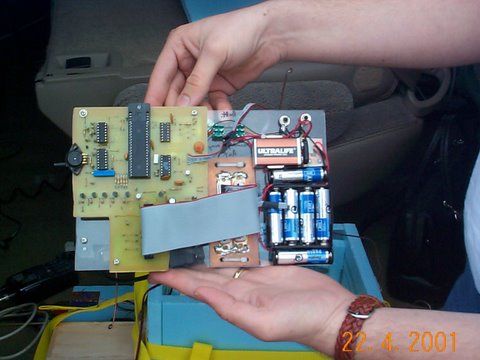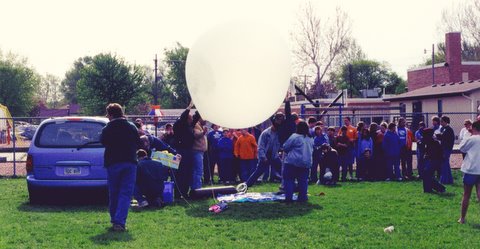Paul Verhage, KD4STH of NearSys originally passed the bug on to me (Zack Clobes, W0ZC) on a quiet weekend in June of 1999. Paul was in town performing a series of flights for the Kansas Cosmosphere and Space Center, and several members from the local ham radio club (RCKARA) attended the event. I was fortunate enough to ride along in one of the chase vehicles, and that's where I got bitten.
Now ten years later, I don't quite recall how it happened, but my boss at work, Casey Swarts, had a couple of kids in a local grade school where he and I had both attended as kids. He had been staying involved doing rocket launches and such, and somehow the idea of high-altitude ballooning appealed to him as a school project. This concept of school involvement provided our initial justification to get the project off the ground.
Being the odd cross of hardware designer/software engineer that I am, I opted to build our entire APRS tracking system from the ground up with the help of long-time group member Jon Riley, AJ0NR. Our first controller board began to take shape in late 2000.

This board flew for the first (and only) time on Sunday April 22, 2001, where we tracked it 172 miles out of the state of Kansas to near Beatrice, NE, aboard Project: Traveler Flight 2001a. That flight was not intended to "travel" that far, but we failed to put enough Helium in the envelope. After that flight, Casey dubbed this the "Project: Traveler" and designed the group logo.
The tracking board quickly evolved into a more compact and efficient flight controller/TNC combination, which I cleverly dubbed the APRS Flight Controller. This board has gone through several iterations over the years, but has been a staple on almost every flight we've made with only one failure due to a bad trace on the PCB.
All the while I was simultaneously developing a piece of tracking software called Balloon Finder, which also evolved considerably over the years to not only include a set of gauges, alerts, and statistics, but also had its own built-in home-grown mapping component based on the government's Tiger map data. The original purpose of this software to give the 6th grade students something to look at besides just a map to keep them engaged.
The group with much encouragement and support from the RCKARA ham radio club, made a total of three flights before we showed up at Wiley Elementary School for our fourth launch in front of dozens of students. We were experts.

My memory is a little fuzzy as I didn't actually stay at the grade school (I went on to chase), but Casey stayed at the school with several other hams, including a few from Wichita who were helping out with our ATV downlink. From what I understand, the kids loved it, learned a lot about the science, and we got a nice full page color write-up in the local newspaper.
For better or for worse, that was our only school involvement to date. We've gone on to make another 11 flights over the next four years and have loved every minute of it. I've continued to develop our APRS Controller Board, and the Balloon Finder software continued to mature to the point that it was a very capable tracking system.
Finally in 2005, after hosting two Great Plains Super Launches (GPSL), the Perfect Storm hit the group and the energy was all of a sudden gone. It was no one's fault, life just happened and we made a conscious decision to store away our equipment. None of us really wanted to do it, and I think all of us close to the project were deeply saddened, and feared that it was over for good. We'd had an enormous amount of fun over the years, and had met so many great people through the hobby that it was hard.
Fast-forward to the summer of 2009, almost a full four years after our last flight. My wife Crys and myself were finally able to break away and travel up to Topeka for the GPSL 2009 symposium/launch. I mostly wanted to see my old friends that had I met along the way at what Crys referred to as "almost a family reunion." The symposium was great, and getting to see everyone was great.
Saturday, we observed about 10 different groups test, inflate, and launch their payloads into the stratosphere. Crys and I had geared up to chase Paul's balloon, and I don't think we had left the launch site when Crys turned to me and asked when we were going to launch our next one.
That's all it took. With four years of down-time behind me, I've come up with a lot of new ideas. I hope to document the progress on those ideas here at the new home of Project: Traveler, a research project of Custom Digital Services, LLC. Our "first" flight after our break is scheduled on Crys's birthday - March 20th, 2010.
I would like to take this opportunity to thank some important people who have defined and guided Project: Traveler. At the risk of forgetting someone, I'd like to thank my wife Crys for leaving me alone for literally thousands of hours over the years while I soldered and programmed. My grandfather George who has provided countless insights and ideas in the development of this project. To Jon, Brenda, and family for sticking with the group on every single launch, start to finish. Countless members of the RCKARA radio club for their encouragement and financial support over the years. Casey for providing the "in" at the grade school, which really fueled this insanity in the beginning. And many, many other individuals and businesses who have given their support over the years.
Thank You.
Zack Clobes, W0ZC
Project: Traveler
